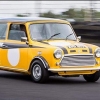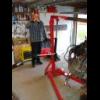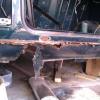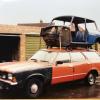Edited by castafiore, 11 January 2015 - 12:07 PM.
3M Panel Adhesive For Sills?
#16

Posted 11 January 2015 - 12:05 PM
#17

Posted 28 October 2015 - 11:14 AM
Hi,
I just used 3M panel adhesive 08115 along the rear three panels between the rear boot panel, the boot floor and the rear valance while replacing these sections. My main objective was to create a really good seal here / corrosion protection but still maintain or improve on strength. I spoke with a representative of 3M who said that it is good to take a spot weld within 30 mins of application. On the boot to floor section, as I didn't have access to a spot welder at the time, I just used a few plug welds also, spaced only about 6-8 inches apart letting the adhesive do the main work. The panel adhesive bubbles a small bit near the welds but overall the joint is really well sealed. On the valance I used only panel adhesive and got a even better result. Make sure you clamp nice and tight the while way along!
Given the strength tests we have seen on this product and how is most instances the metal itself will tear before the adhesive joint, my advice, and if I was doing the repair again would be use adhesive only. Its far stronger and seals the joint perfectly. Make sure to sand to bare metal and clean with grease and silicone remover (paint prep) before using adhesive. If the joint is finished off correctly and nice and clean, no MOT inspector is going to know any different. You can just say the welds were ground down and low spots on the spot welds were filled before paint. If you really feel necessary just run a few seam welds down the lower part of the sill where it meets the floor.
There is a product called LORD Fusor 108B which is specifically made for this. ie seal, corrosion protection and spot weld at the same time. It has microscopic balls that retain conductivity for the resistance weld and supposed to be the dogs. Unfortunately cant seem to get it here as its an Australian product I believe.
Bottom line for me is that the Mini is so prone to rust and corrosion as a result of mainy its exposed seams and spotwelds even after paint that either of the products above should be used everywhere possible in order to seal the bodywork up at repair stage. Wings, A-panels, windscreen seams, sill seams etc. Embrace the new technology people! BMC/Leyland would have used this at the time if it was around. All the main manufactures are using this stuff now, Nissan, Toyota, Ford, Chrysler, GM, Mazda, etc. etc. ![]()
#18

Posted 28 October 2015 - 11:54 AM
No
#19

Posted 28 October 2015 - 01:39 PM
#20

Posted 28 October 2015 - 02:42 PM
What you have to remember is the car was designed to be welded together not bonded. So whatever design process / testing etc was done using that method was approved as such.
And yes I fully understand processes have changed that enable structural panels to be bonded together BUT they have been through a design process that has been signed off to say the process is suitable for use in that particular design. It will have had testing to ensure it meets that requirement. A mini shell never has. I know we do things to our cars that are not as per design and that is a risk a lot of mini owners take however there is the IVA process to go through that will in theory approve those modifications. ( we won't open that can of worms however)
IF and its a big IF you have an accident, an investigation is carried out and they find the vehicle has been bonded together with a structural adhesive process then this will then draw the question as WHY. Your insurance could then be invalidated, any claim you have thrown out and potentially you could then be billed for damages, injuries etc etc.
It's not a case of scaremongering but a reality of modern insurance finding ways to not pay out.
Just to add something to this we use a Redux bonding process on some elements of aircraft structure ( older types many no longer flying ) in this case if we had to split said parts of the structure we then had to rivet it back together because we could not duplicate the factory method of carrying out this process successfully in situ. This was with design approval from the maunufacturer not because somebody said it would be OK. Without it we could not do it. So you could apply the same principle in this case.
I would love to be able to bond a car together ( no noise and a lot less mess) but unless the conditions met the requirements fully and the car was tested and approved then you are playing with fire.
#21

Posted 29 October 2015 - 09:40 PM
sonikk4 makes a good point in relation to insurance etc. although for bonded panels to become an investigation, an insurance company would have to be investigating the cause of the accident/injury as the failure of the structural itself which is extremely unlikely given that we know the bond is as strong as the spot welds. In saying that, I agree that if this was brought forward I have no question that your insurer would leave you high and dry, this applies to any repair or modification.
When these cars were designed originally my understanding is that there would have been no consideration to integrity under impact and the only consideration would have been to ease and cost of production. Any testing would have only been to integrity under normal driving conditions and meeting requirements would have been very different story back then when they didn't know we were about so modify the performance significantly.
To say they were designed in this manner so must be repaired in the same way is not intuitive to improving the performance of the structure. I agree that there may be some risk in only bonding certain areas alone that were designed to be spot welded but a combination of both, especially using an adhesive product that is designed to be spot welded is only and improvement. Thats just my opinion, and its a long time since I studied engineering and am by no means an expert. And as sonikk4 says previously unless these particular panels were tested in an appropriate manner its impossible to say.
But in my view, an appropriate panel adhesive like Lord Fusor in combination of the normal spot welding is a good idea given its added strength and corrosion resistance. The only considered risk is deciding to bond solely in some areas, ie rear valance, wings etc but I certainly wouldn't have thought it was playing with fire. But I could be wrong. Any feedback from people in the know?, or has anyone come across data from structural analysis of bonded panels vs spot welded I would love to see. May the force be with you.
Edited by davefitz, 29 October 2015 - 09:41 PM.
#22

Posted 29 October 2015 - 10:56 PM
I think it is one of those things where it doesn't really matter what anyone may think, regardless of how knowledgeable they are, or whether they can provide good technical justification for it's validity etc.
The simple fact of the matter is that the only test of 'roadworthiness' we have (ie the MOT) requires that panels be joined by welding, and therfore unless that changes to include and allow the use of adhesive bonding retrospectively on cars such as minis where it was not the original method of assembly, then any car which is bonded has 'cheated' the MOT and as such would be invalidated.
For this reason, Sonikks comments about it being risky in terms of insurance voiding and the consequences of that in the event of a serious accident, must stand.
#23

Posted 30 October 2015 - 06:03 PM
I restoring an MGB and needing new rear wings, as opposed to just the lower half of the wings, it is necessary to bond the wings on as there is no access for a welding torch along the top edge. On the Mark Evans MGB resto programme 'An MG is Born' they used this process. It doesn't seem to be an issue, but the MG is a very strong structure.
I don't know that I would want to use it on Mini sill structure.
#24

Posted 23 April 2020 - 11:10 AM
https://youtu.be/hXk5Y9zg1dY
#25

Posted 23 April 2020 - 12:14 PM
from a corrosion protection perspective it looks like it could be pretty useful.
1 user(s) are reading this topic
0 members, 1 guests, 0 anonymous users



















